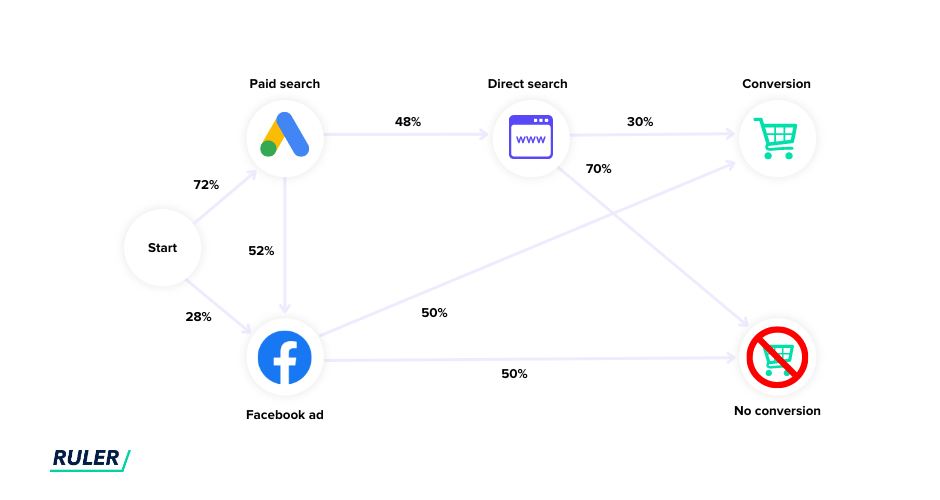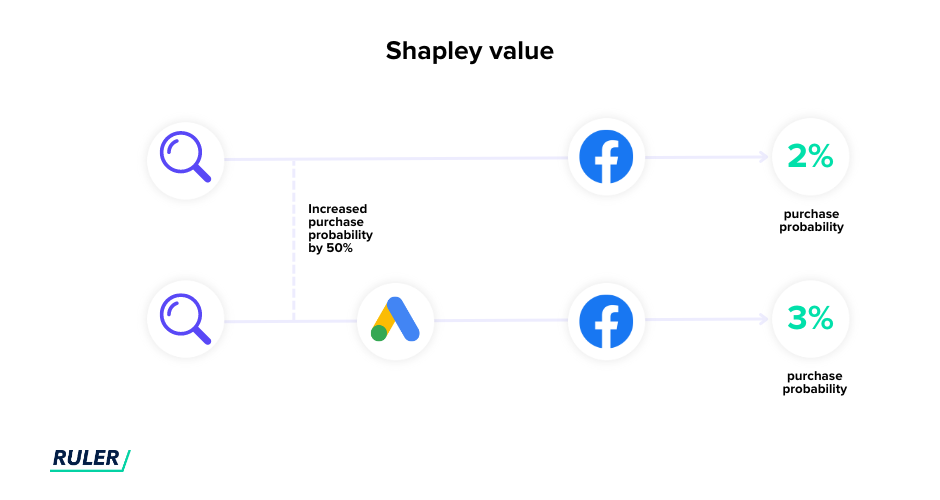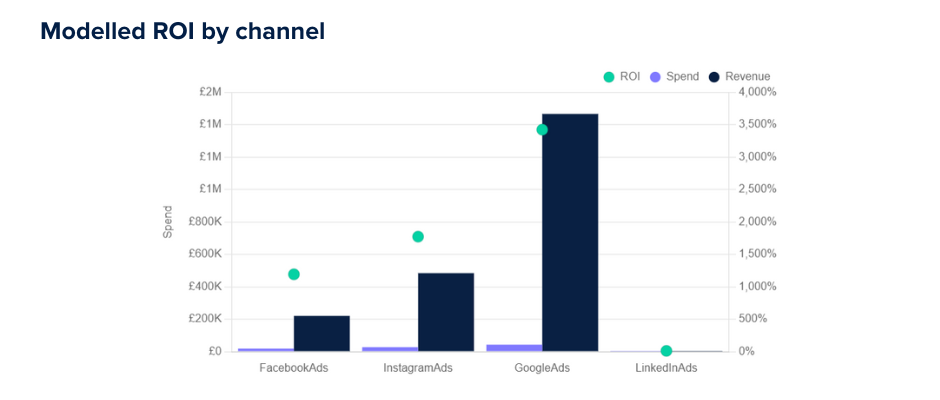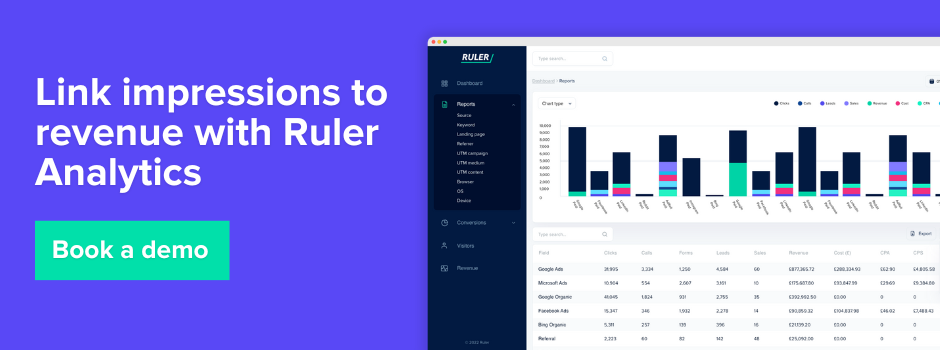Dive deeper into probabilistic attribution and its role in shaping the future of marketing measurement.
Marketing measurement is facing a turning point.
For years, the industry has relied on deterministic attribution, but with third-party cookie limitations and stricter privacy regulations, this method struggles to capture the full picture.
This shift demands a new attribution approach to capture the intricate, multi-touchpoint journeys of today’s consumers.
Probabilistic attribution, which assigns credit to touchpoints based on statistical models and machine learning, presents itself as a potential answer.
Here’s what we’ll cover:
💡 Pro Tip
Ruler goes beyond traditional methods by analysing both clicks and ad impressions. It considers both deterministic and probabilistic factors to accurately attribute conversions and revenue not only to clicks, but impressions too.
Skip to the part about Ruler or book a demo to see how it can give you a better view of your marketing channel performance.
Probabilistic attribution lives up to its name by using probabilities to assign credit.
Unlike traditional deterministic methods that rely on user identifiers (IDFA, GAID), probabilistic attribution uses statistical models and machine learning to estimate the likelihood of each touchpoint influencing a conversion or revenue.
It analyses user behaviour and compares it to existing data to determine the possible role each interaction played in the customer journey.

While not as precise as deterministic methods, you can expect to see more probabilistic attribution as third-party cookies and other identifiers become less reliable.
For years, deterministic attribution in platforms like Meta and Google have relied on unique identifiers like cookies, IDFA (Apple’s Identifier for Advertisers) and GAID (Google Advertising ID) to track user behaviour and attribute credit to specific ads.
These unique IDs, assigned to individual devices, allow for more precise targeting and measurement, forming the backbone of many digital marketing strategies.
However, things took a turn back in April 2021 when Apple rolled out iOS 14.5. This update introduced App Tracking Transparency (ATT), allowing users to choose whether they want to be tracked across apps and websites.
While the industry-wide opt-in rate has increased to 34% in 2023 (up from 29% in 2022), a substantial portion of users remain untracked.
This, along with Google’s plan to give users the option to opt out of third-party cookies, has undoubtedly made user behaviour tracking and campaign measurement more complex.
Related: How to prepare for the death of third-party cookies
Instead of relying solely on these deterministic identifiers which are becoming increasingly unreliable, advertisers are turning to probabilistic attribution to predict user journeys across touchpoints and measure marketing effectiveness.
Even before factoring in developments such as third-party cookies and iOS 14.5, in-platform attribution had its issues. Let’s look at a few reasons why.
Think of the last purchase decision that you really put thought into–like a car or holiday.
Did you see one ad and immediately whip out your credit card?
Probably not. You likely researched, compared options, and took the necessary time before arriving at a decision.
The problem? Ad platform attribution windows are often too short to capture this reality. These windows define the timeframe for assigning credit to an ad that leads to a conversion (like a sale).
For example, Meta assigns credit for conversions to ad clicks that occur within seven days and views within just one day.
Previously, before privacy limitations, Facebook allowed for 28-day click, 28-day view and 7-day view windows, but these were still considered too short.
These limited windows make it hard to see the full customer journey. Display and brand awareness campaigns, which plant the seeds of interest, are often left invisible.
Meanwhile, channels at the purchase decision stage, like direct search and organic traffic, reap all the benefits as if they did all the work.
In-platform attribution models, like those offered by Google and Facebook, can be biassed.
Why? They have a vested interest in making their platforms look like the sole heroes of your marketing success story, encouraging you to spend more.
Let’s break it down.
Imagine a customer sees an ad on Facebook, clicks through to your site, but doesn’t buy anything.
Later, they search for your brand name, click on a Google ad, and then make a purchase.
While we know both platforms played a role, Facebook and Google only see their own contribution. Facebook claims credit for the initial spark, while Google takes credit for the final click.
With this scattered information, it’s difficult to identify the channels truly driving sales, leading to misplaced budget allocations and missed opportunities.
Let’s recap.
As third-party cookies become less reliable and privacy regulations strengthen (like ATT), marketers are turning to probabilistic attribution to understand campaign effectiveness.
Next question—how do you get this thing rolling?
Tech giants like Meta and Google are innovating ways to track marketing effectiveness as we moved towards a privacy-centric era.
Their solutions, like Facebook’s Robyn and Google’s Privacy Sandbox and Meridian, ditch dependence on individual user data tracked by third-party cookies.
Instead, they leverage sophisticated machine learning models to provide marketers with a general understanding of ad performance at a broader audience level.
However, as mentioned earlier, data sharing between tech giants like Facebook and Google is limited. This fragmented view, where each platform operates as a “walled garden,” hinders true holistic understanding of ad performance.
To overcome this challenge and gain a comprehensive, cross-channel view, you can utilise dedicated probabilistic attribution tools.
These solutions analyse data from various platforms and estimate the contribution of each touchpoint (like a Facebook or Google ad) to a conversion and revenue, even if user data isn’t directly shared.
Let’s use Ruler as an example.
First, we’re continuing to leverage the power of deterministic attribution by tracking click-path journeys through first-party cookies and unique identifiers.
Not all cookies are fading away. First-party cookies are going strong, serving as valuable identifiers for tracking information about visitors on your website.
By mapping these click-paths, we gain crucial insights into which channels attract our best leads and customers, and how they navigate our pages before converting.
Without this data, we wouldn’t have the necessary insights to optimise our content and marketing efforts for maximum impact.
In addition to our deterministic attribution, we also leverage probabilistic modelling. This advanced machine-learning approach, that uses a Bayesian statistical model and Shapley Regression, goes beyond clicks and considers how impressions influence conversions and revenue.

Ruler takes clicks, cost and impression data from all your ad platforms to create a holistic and unbiased report that shows the true impact of your campaigns.

With the deterministic and probabilistic data in Ruler, you can:
💡 Pro Tip: One of our customers experienced a 40% drop in direct traffic conversions after implementing impression attribution.
Deterministic attribution excels at tracking individual user click journeys, but it benefits greatly from the broader perspective offered by probabilistic attribution.
This combined approach provides a more complete picture of how marketing influences revenue and ROI, ensuring credit is distributed fairly to all channels throughout the entire funnel.
Want to see the combined power of deterministic and probabilistic attribution? Book a demo of Ruler, and we’ll show how both methods can work together for optimal decision-making, resource allocation, and clear ROI.
